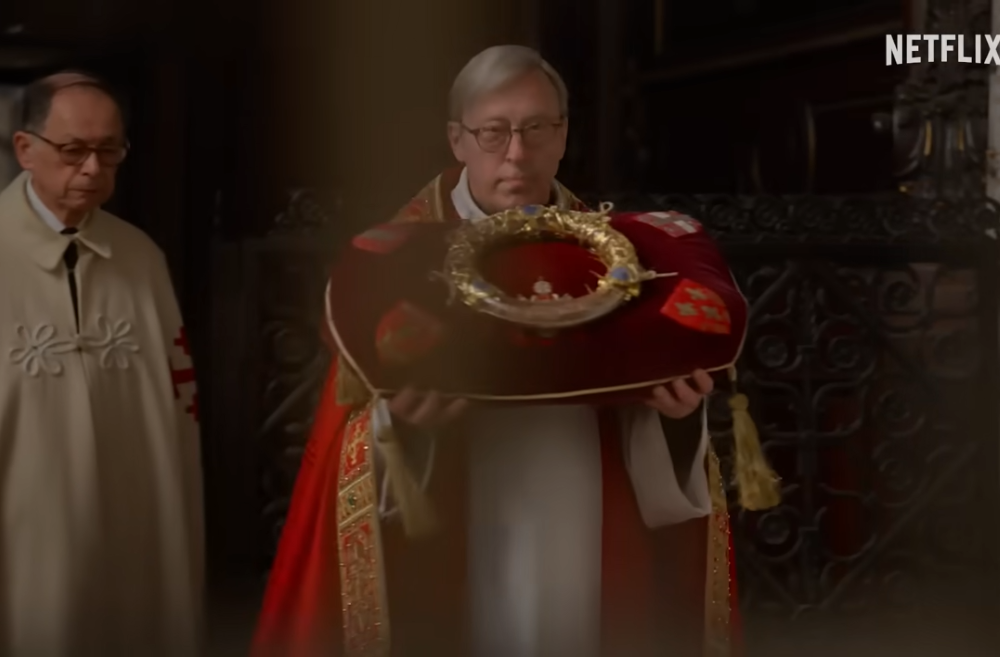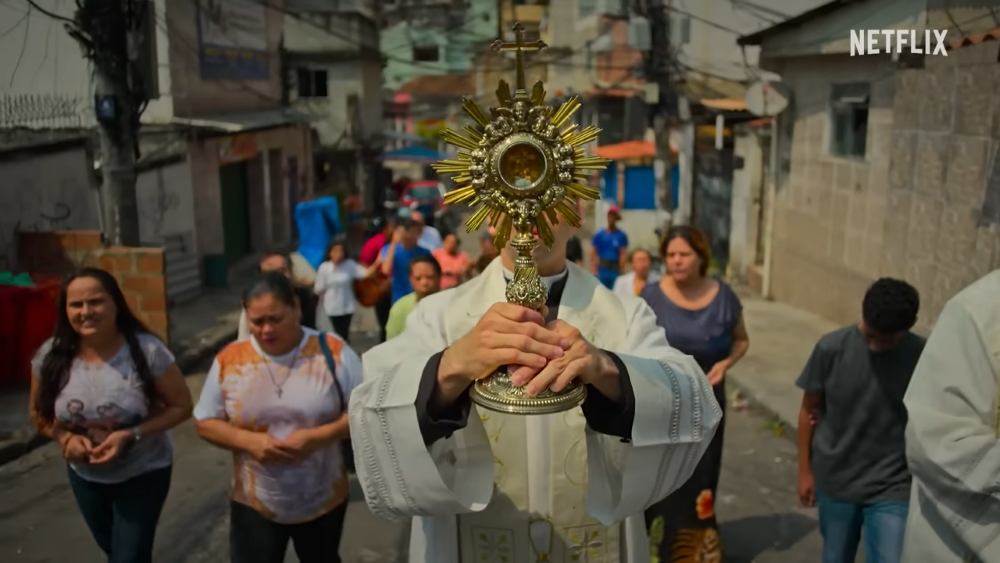
A priest carries the crown of thorns in an image from the Netflix series "Mysteries of the Faith." The relic, held at Notre Dame Cathedral in Paris since the French Revolution, was quickly retrieved from the church when a fire started there April 15, 2019. (NCR screenshot/YouTube/Netflix)
What is the power of belief? And how do fragments from the distant past hold and shape this belief? These questions are at the heart of the four-part Netflix series "Mysteries of the Faith," which examines the role of relics in the Catholic Church today.
Each episode highlights a specific passion relic, or object, that Jesus interacted with during his death on the cross or in his tomb. explaining its story, past and present, often shrouded in legend. The series also features the people who care for and venerate these sacred objects. Well-suited for both novice and practiced devotee, the series provides detailed explanations about relics themselves and their significance without losing sight of their personal impact.
The first episode centers on Jesus' crown of thorns and its momentous history. Beginning at the cross as a symbol of mockery, it later became imbued with meaning as an object stained by Jesus' blood, providing a special connection to that holy moment in time. The crown's later passage from Constantinople to France is artfully narrated through stained glass depictions in St.-Chapelle in Paris, where it resided until the 18th century, finally moving to its contemporary residence in the Notre Dame Cathedral after the French Revolution.
The contemporary significance and emotional resonance of the crown of thorns is highlighted by the April 15, 2019, fire that spread throughout Notre Dame. The Paris fire chief explains how this relic was the first item to be retrieved, despite firefighters having no direct map to its location, given its unique holiness. Through its safe retrieval from the flames, the relic became a new symbol of hope and the perseverance of faith amidst tragedy.

A priest carries a relic during a procession in an image from the Netflix series "Mysteries of the Faith." (NCR screenshot/YouTube/Netflix)
The second episode examines what happens when the histories of these relics become contested. While most people would associate the Holy Grail from the Last Supper with medieval lore and King Arthur, this episode places the grail in Spain, where three local historians debate its current location, two placing it in the Valencia Cathedral and one in Léon, where it is known as the Chalice of Urraca.
While the history and location of the chalice itself may be disputed, both draw the attention and faith of devotees, raising questions concerning the importance of historical authenticity in matters of faith. There is a particularly touching moment as a historian recounts a woman who approached her, wanting to touch the hands of someone who worked with the Holy Grail.
This episode also depicts the role of miracles and their connection to relics. Rocco Rulli, a Manoppello resident, shares how the relic of the Holy Face, Christ's resurrection veil, has protected his family throughout generations, most notably when his daughter Francesca was healed from a fatal brain hemorrhage 24 hours after a special Mass was celebrated for her.
Francesca prefers to call it a gift among many gifts rather than a miracle, saying in an interview, "I believe that the Holy Face saves my life every day." The next scene presents her father in the processional carrying the grand display of the Holy Face, demonstrating the integration of these relics into the everyday moments of life as well as the most significant.
The third episode moves to the cross itself as the most prominent icon of Christianity. The history of the relic of the True Cross begins with Empress Helena in the fourth century, when she embarks on a pilgrimage to Jerusalem and discovers three crosses, the True Cross being revealed when a corpse revived after being placed on it. Once discovered, this cross, like many other relics, is fragmented and sent to various locations, each piece carrying the full power of the whole cross.

The relic known as the Holy Face is seen in an image from the Netflix series "Mysteries of the Faith." (NCR screenshot/YouTube/Netflix)
Shifting to present day, the episode highlights a canon in the Rio de Janeiro Cathedral, Cláudio dos Santos, who wants to utilize the relic of the True Cross as an evangelization tool, taking it out of the cathedrals and into the favelas, areas stricken by poverty and gang violence. As the procession moves through the streets, a woman from the community describes how the cross garnered reverence from everyone gathered. Even gangsters bowed their heads.
The final episode tackles the question of modern-day saints, beginning with the story of an Italian judge, Rosario Livatino, who spent his life fighting corruption but was murdered by mobsters in 1990. While the process of beatification began shortly after his death, he was officially declared a martyr by Pope Francis in 2020. His blood-stained shirt was preserved by the cathedral in Agrigento, becoming a modern relic of the Catholic Church. Livatino's life and death embodies Pope Francis' call for the necessity of everyday saints, the people who comprise the living blood of the church.
This episode also examines questions of authenticity surrounding the veil of the Holy Face and the shroud of Turin. While in both cases, scientific examination declared them fake, the transcendent quality of belief surpasses scientific scrutiny. Don Gero, custodian of Livatino's Holy Shirt, states, "Every time I hold the relic in my hands, it sends a shiver down my spine. A thousand thoughts go through my mind about how, despite all the difficulties we encounter in life, holiness is within reach … A bloodied shirt with two bullet holes speaks to a teen without the need for words."
Advertisement
Whether voiced through historians and scholars, or priests and devotees, this series gestures toward an innate human need for belief, for miracles, and the power of relics to provide a physical touchpoint, something to behold and connect one more directly to the passion of Jesus Christ. Each episode highlights the intricate care these objects receive, their storage in vaults, various caretakers who spend their lives guarding these relics, and the select few who touch them, carefully placing them on altars or holding them during processions.
Although "Mysteries of the Faith" is ostensibly about various relics connected to Jesus and their multifaceted histories, it is equally about the people who worship them, the strength of their faith in these sacred objects and the ways it shapes their lives.
While this show is not explicitly religious or affiliated with the Catholic Church, it foregrounds the perspective of believers over skeptics. Commentary from academics provides historical background and context as well as the psychological and spiritual impetus for belief.
Like the relics themselves, "Mysteries of the Faith" brings together past and present, as the historical journeys of these sacred objects narrated by historians are set alongside current worship practices. The moving scenes of people in the presence of these sacred objects and miracle stories make a compelling case that relics are not simply things of the past, but powerful sources of belief even today.







